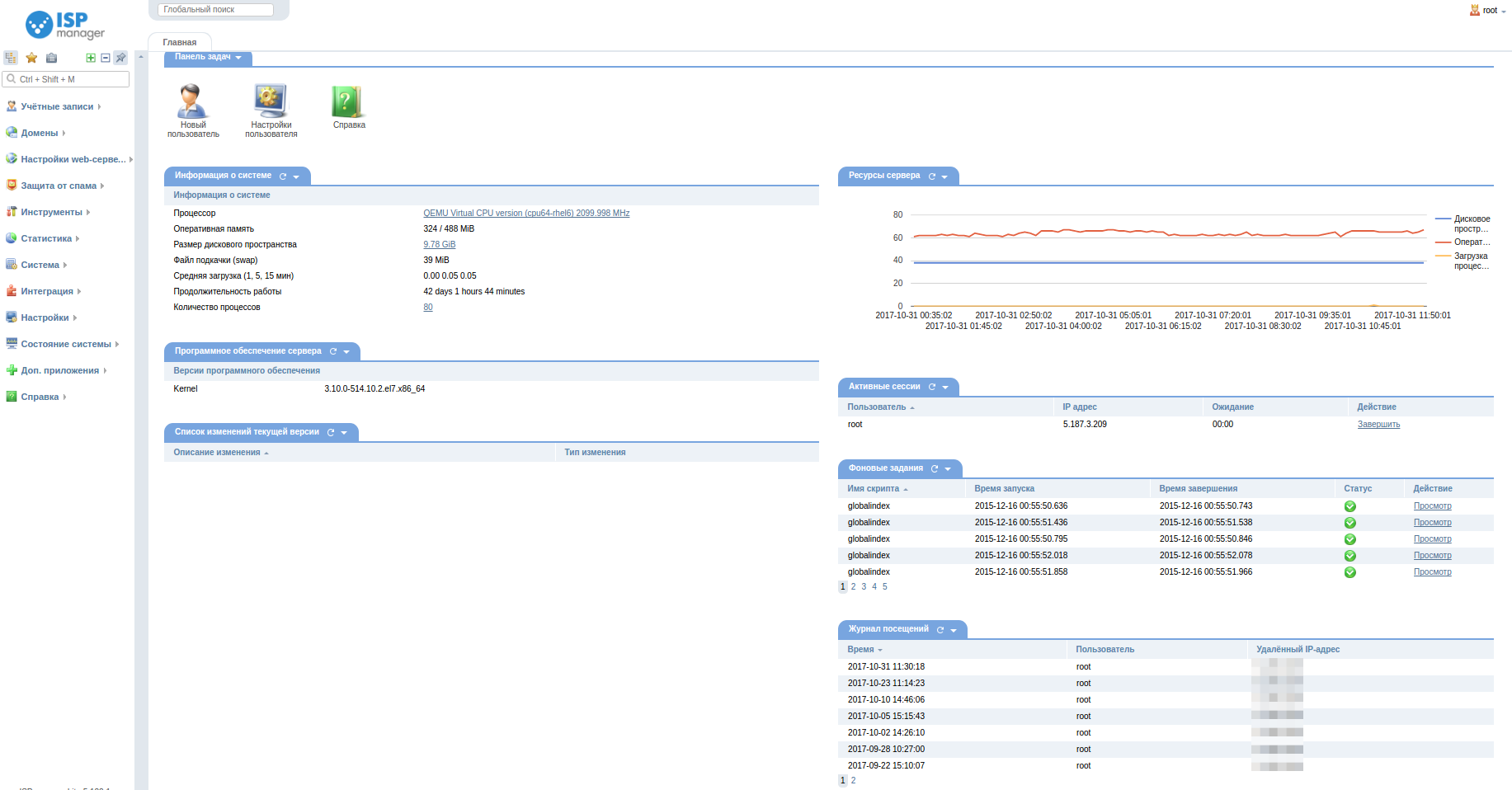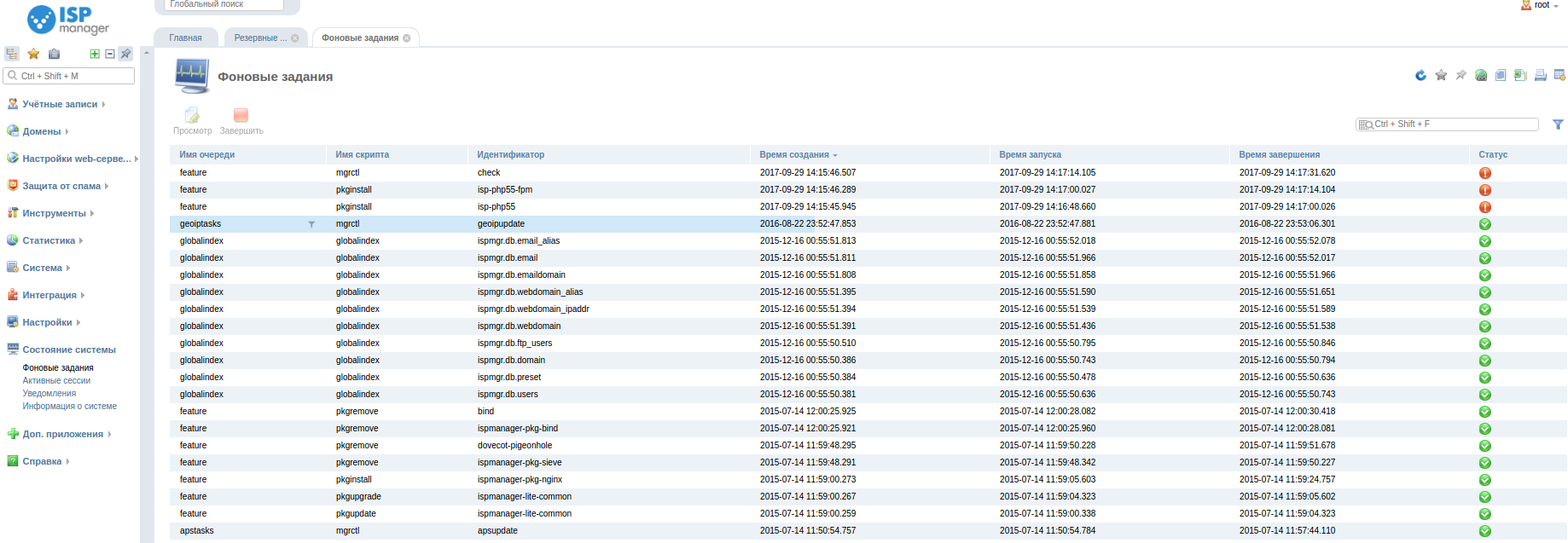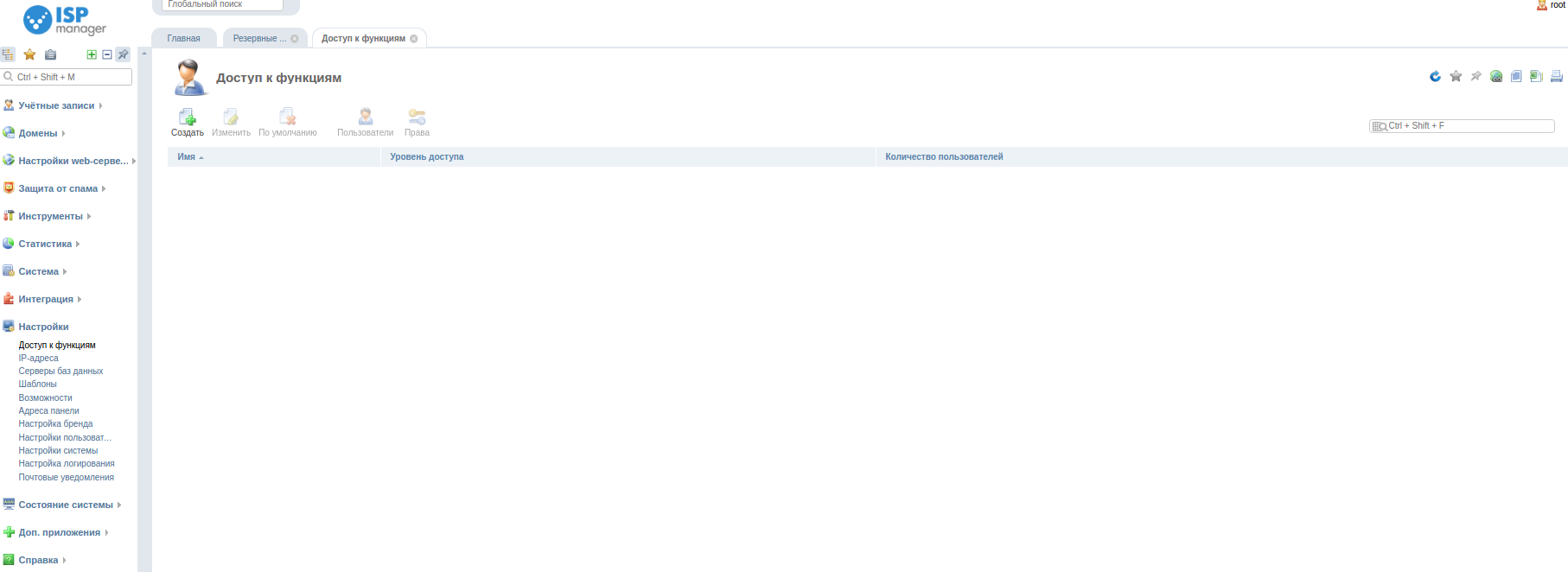Панель управления сервером ISPmanager5
ISPmanager – это панель управления выделенными и виртуальными серверами, которая позволяет при помощи веб-интерфейса управлять различным программным обеспечением. Это может быть как создание неограниченного количества пользователей, веб-серверов (Apache или nginx), так и СУБД (MySQL, PostgreSQL), почтовых серверов (Sendmail, Exim) и т.д.


Основные возможности ISPmanager:
Создание и управление пользователями/шаблонами пользователей. В том числе выставление ограничений для пользователей/шаблонов пользователей.
Учетные записи
-
Администраторы - управление учётными записями администраторов панели управления.
-
Пользователи - создание и изменение аккаунтов с возможностью настройки квот на ресурсы системы и доступа к дополнительным возможностям.
-
FTP-пользователи - управления учетными записями для доступа по FTP.
-
Почтовые ящики - управление почтовыми ящиками сервера.

Создание и управление web доменами. Возможность выбора режима работы php, установка SSL сертификата, быстрая установка популярных cms на домен, настройка редиректов и ssl перенаправлений, управление почтовой системой. Создание почтовых доменов и ящиков. Установка пересылок и почтовых алиасов. Почтовые фильтры. Поддержка DKIM.
Домены
-
WWW-домены - настройка доменов, находящихся под управлением web-сервера.
-
Почтовые домены - настройки доменов, на которые осуществляется приём электронной почты.
-
Доменные имена - управление DNS (Domain Name System).
-
Зарезервированные доменные имена - управление списком доменов, запрещенных для создания пользователями.

Настройки web-сервера
-
SSL сертификаты - управление ключами защищенного доступа.
-
Каталог web-скриптов - коллекция web-скриптов, которые можно установить на WWW домены.
-
Настройки PHP - настройка основных параметров PHP.
-
Расширения PHP - управление расширениями PHP, с возможностью их подключения и инсталляцией дополнительных.
-
Расширения PERL - установка дополнительных расширений PERL.
-
Расширения Python - установка дополнительных расширений Python.

Системы защиты от спама.
Защита от спама
-
Белый список (для Greylisting) - управление списком хостов, которые не будут задерживаться Greylisting.
-
Белый список - управление списком хостов, с которых вы хотите принимать электронную почту.
-
Черный список - управление списком хостов, с которых запрещено принимать электронную почту.

Управление базами данных. Создание баз данных и пользователей баз данных. Выставление для пользователей баз данных прав доступа. Управление ftp пользователями. Создание, включение, отключение ftp пользователей. Возможность выставить пользователю домашнюю директорию.
Инструменты
-
Выполнить команду - позволяет выполнить команду на сервере без входа по ssh
-
Перезагрузить сервер - выполнить полную перезагрузку сервера.
-
Резервные копии - модуль управления резервными копиями.
-
Обновить панель - выполнить обновление панели ISPmanager.
-
Базы данных - управление базами данных MySQL и PostgreSQL, пользователями, доступом и т.д.
-
Импорт пользователя - модуль предназначен для импорта пользователей и их данных из различных источников.
-
Shell-клиент - подключение к shell сервера из web-интерфейса.

Система резервного копирования.
Резервное копирование
-
Настройки - создание заданий на резервное копирование данных сервера.
-
Хранилища - создания и управление местами для хранения архивов резервных копий.
-
Резервные копии - управление ранее созданными резервными копиями.
-
Сохраненные данные - управление сохраненными данными.
Статистика по потребляемым ресурсам, а именно: статистика использования ресурсов системы, подсчет трафика, текущая активность и журнал событий.
Статистика
-
Активные сетевые соединения - информация об активных соединениях к серверу.
-
Использование ресурсов - информация об использовании ресурсов пользователем панели управления.
-
Журнал операций - полный журнал операций, выполненных пользователями.
-
Журнал посещений - журнал посещений пользователями панели управления.

Редактирование файлов через панель управления. Выставление прав доступа на файлы и директории.
Система
-
Менеджер файлов - доступ к файловой системе сервера.
-
Сетевые службы - управлением использованием различных сетевых служб.
-
Службы - отображает список запущенных сервисов.
-
Плагины - управление плагинами.
-
Брандмауэр - защита и ограничение доступа к серверу или отдельным сервисам.
-
Планировщик - настройка периодически выполняемых заданий.

Состояние системы
-
Фоновые задания - информация о фоновых заданиях, выполняемых в системе в настоящий момент.
-
Активные запросы - мониторинг текущих запросов к панели управления.
-
Активные сессии - мониторинг текущих подключений к панели.
-
Уведомления - информация о проблемах, которые возникли во время работы с панелью, с возможностью их решения.
-
Информация о системе - информация о текущем состоянии вашего сервера.

Интеграция
- Внешние серверы имён - добавление и управление внешними серверами имен.
Разграничение прав доступа для пользователей.
Настройки
-
Возможности - управление возможностями панели управления (эквивалент разделу "Программное обеспечение". Раздел доступен, если панель установлена из пакетов).
-
Доступ к модулям - управление ограничениями доступа к отдельным функциям.
-
Серверы баз данных - управление настройками серверов баз данных (локальных и удалённых).
-
Адреса панели - настройка доступа к панели управления.
-
Программное обеспечение - установка и включение дополнительного ПО для управления вашим сервером (эквивалент разделу "Возможности". Раздел доступен, если панель установлена из скрипта установки).
-
Связь с DNSmanager - настройка параметров для интеграции с панелью управления DNSmanager.
-
Настройки бренда - изменение логотипа, цветовой гаммы панели управления, ссылки на веб-сайт.
-
Настройки пользователя - выбор языка, пароля для входа в систему и установка др. параметры для работы с ISPmanager.
-
Настройки системы - настройка основных параметров сервера.
-
Шаблоны - настройка шаблонов для создания пользователей.

Дополнительные приложения
- Доступ к веб-интерфейсу почтового сервера Web-Mail, а также доступ к phpMyAdmin.
Справка
-
Вызов справки - переход на страницу документации программного продукта.
-
Форумы сообщества - переход на форум для обсуждения различных вопросов, связанных с панелями управления.
-
Регистрация ошибки - переход в публичную систему регистрации ошибок.
-
Список изменений - список изменений в версиях ISPmanager.
-
О программе - информация о лицензии на право использования программного продукта.
